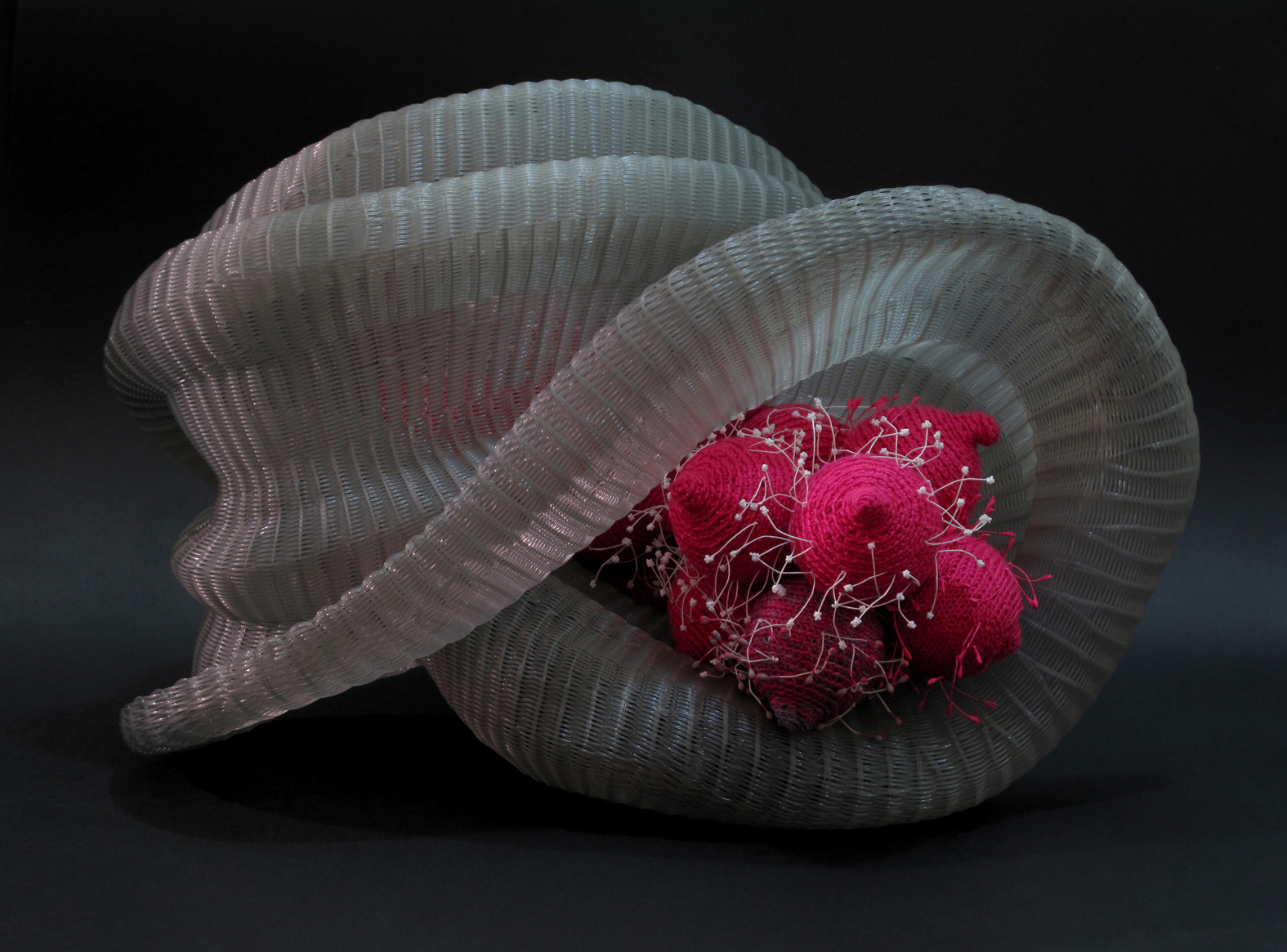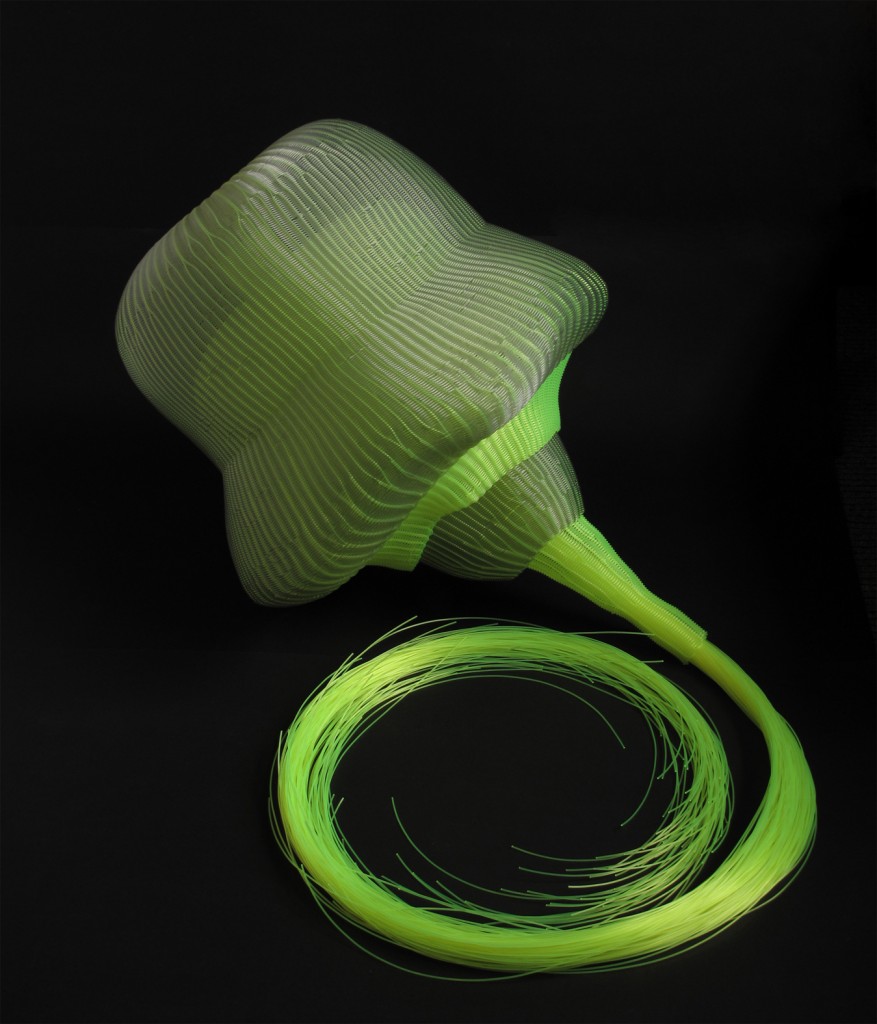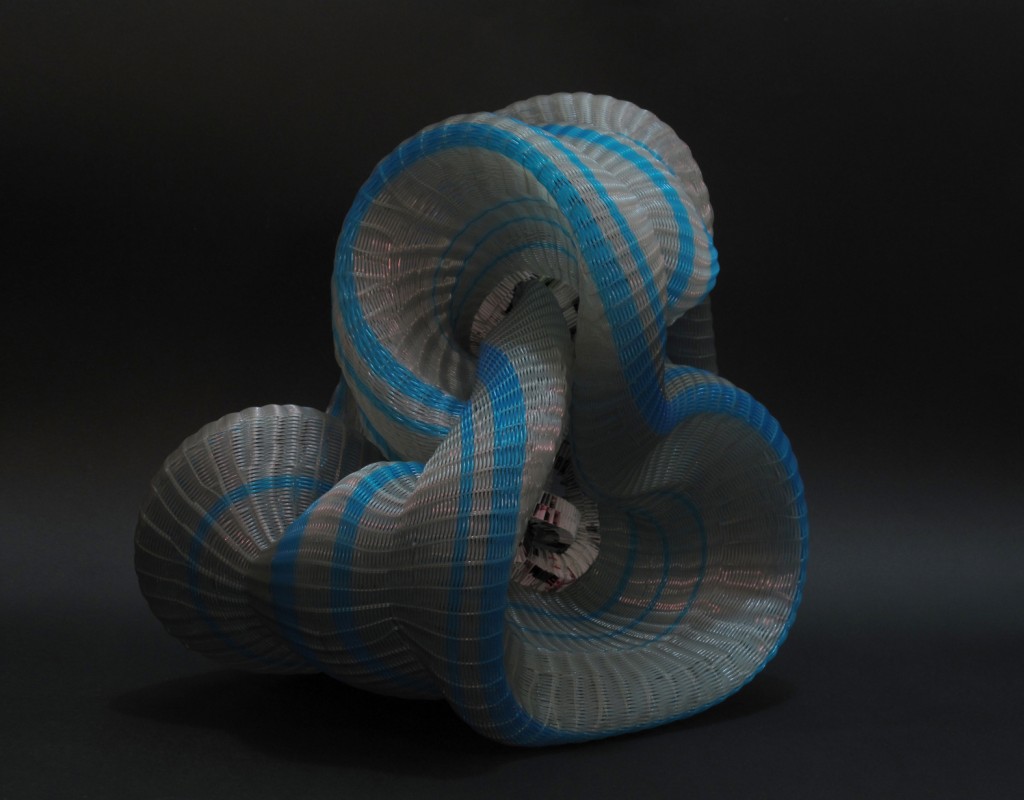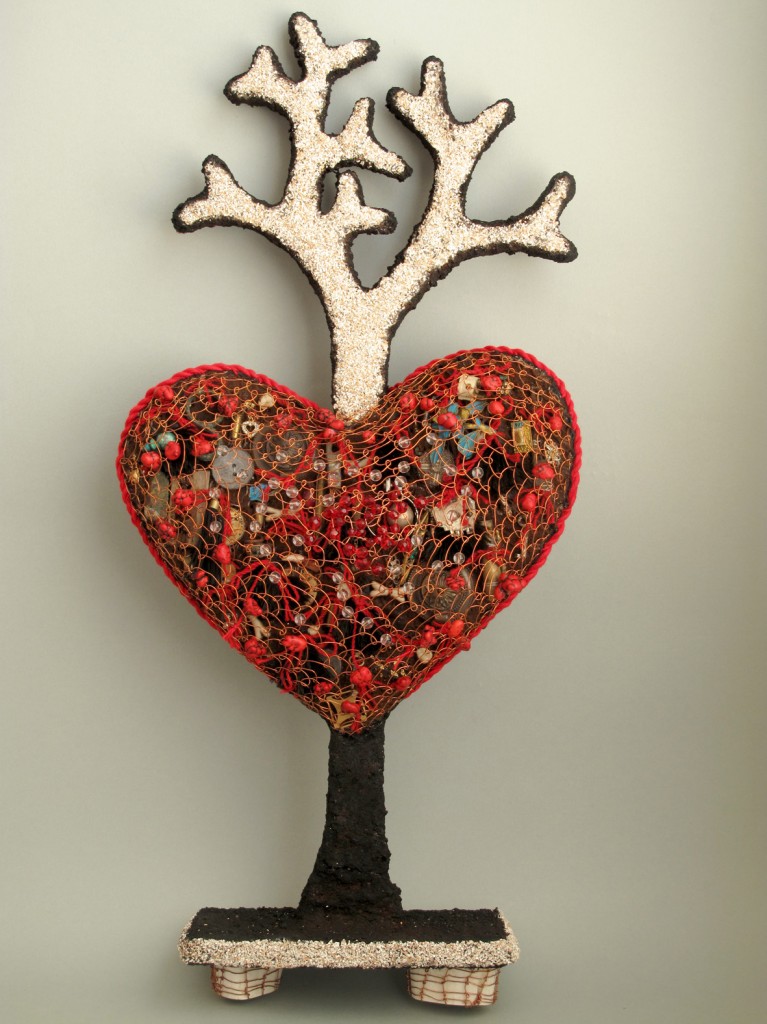Sculptor Minka Gillian talks Sex and Death

Sculptor Minka Gillian explores sex and death in art that merges the artificial with the biological. With eight solo shows and a swagger of group exhibitions to her name, Gillian has been examining the nexus between the organic and synthetic for many years, entering terrain which is intensely personal yet flirts with science and notions of humanity’s broader relationship with the natural world. Art World Women recently spoke with Minka about her biomorphic sculptures, sex and looking death in the eye.
image: Minka Gillian, P.O.D, 2011 Polyester monofilament, cotton, artificial stamen, 42x 28x 29cm
AWW: Synthetic and organic appear to merge in your work. What elements of the natural world are you referencing or inspired by?
MG: I grew up in a mossy valley in Tasmania in bushland with a creek, so spent many hours looking at the miniature world of plants, fungi and water life. We had a large set National Geographic magazines which I would pour over for hours as a child. I have always been fascinated by the body and anatomical diagrams. Art Forms In Nature by Ernst Haeckel and Carl Linneaus’s system of plant classification are great source materials.
AWW: Your work is suggestive of the sexual organs of animal and plant forms. Can you tell us more about this aspect of your work and themes of sex, death and regeneration?
MG: My sculptures seem to have always been able to be classified as either female or male. Sometimes this is a conscious decision on my part other times it is subconscious. I have always been interested in the body and anything to do with sex and death. I guess they are the fundamentals, the beginning and the end!
This is a quote that I like that I feel a certain affinity with as I often use my own emotions and body as a starting point for my work.
The body is a multilingual being. It speaks through its colour and its temperature, the flush of recognition, the glow of love, the ash of pain, the heat of arousal, the coldness of non conviction. It speaks through its constant tiny dance, sometimes swaying, sometimes a-jitter, sometimes trembling. It speaks through the leap of the heart, the falling of the spirit, the pit at the centre, and rising hope. The body remembers, the bones remember, the joints remember even the little finger remembers. Memory is lodged in pictures and feelings in the cells themselves. Like a sponge filled with water, anywhere the flesh is pressed, wrung, even touched lightly a memory may flow out in a stream.
– Clarissa Pinkola Estes*

AWW: What are you working on at the moment?
MG: I am working towards a two-person show with painter Peta Hinton called “Out on a Limb with her Heart on her Sleeve”. The show delves into the inner worlds of the body and the psyche. Both of us have survived life-threatening illnesses that have resulted in the surgical implantation of artificial devices; a pacemaker for a rare heart disease for myself, and an internal prosthetic knee and partial femur after bone cancer for Peta. These personal experiences have provided the initial impetus for the project examining the physical and psychological outcomes of merging the artificial with the biological.
For this project I am making a series of heart altars, a personal take on the Victorian Memento Mori tableau mixed with Mexican Ex-Voto offerings.
AWW: What materials do you use for your sculptures?
MG: Most of my work is made from polyester monofilament, recycled copper wire and found objects. My attraction to synthetic material is mostly due to its translucency and seemingly fragile, delicate appearance; which once woven is in fact very strong. My sculptures don’t usually have an internal armature so they are self supporting. Its strength and ability to keep its shape is most important.
Also I want to make durable not ephemeral sculptures.
I think its important not to lose the ability to play, something that I have suffered from as my work is time consuming. It’s hard to have time to play with ideas, as the process is so slow. Ideas pile up one on another in a scramble to get out. I have to be very focused and disciplined to get them done. Last year I taught some architecture students a sculpture class using mostly common objects one could find around the home, this re- invigorated my own interest in material and play.
AWW: You employ delicate and intricate weaving to form your sculptures. Can you describe your technique and process for us?
The majority of my work is woven using twining, which is a basic basketry technique. I also use netting and crochet.
The process is very slow and time consuming. Form is produced mostly from tension while I’m weaving, there isn’t an armature, they are self supporting.
Some sculptures can take months to finish so I usually have about 5 or 6 sculptures on the go at once Some sit around the house or studio for months for me to look at till I know what direction they are going to take.

AWW: With the translucency of the materials that you use, how important is light and or lighting to the integrity of the sculptures and our appreciation of them?
The translucency of my sculptures is important, as I like the glass like quality the polyester monofilament creates. Lighting is important as the light creates shadows that allow the viewer to catch glimpses of the internal structure through the thin transparent shells. My sculptures are often simple forms with complex internal structures.
Many of my sculptures are reminiscent of both the external and internal body. Containers of our fluids and organs, these simple but complex objects hide behind thin transparent shells. The skin and the organs of the body are containers for our fluids, looking at the body we seem tight and together, but if we were to examine with the aid of a microscope one would find out that we are not tightly woven structures, but loosely woven forms that let minute amounts of liquid in and out of our bodies. The simple exterior of a body hides a more complex internal system. Just as our bodies are primarily made of water, our minds are made of ideas, constantly changing, absorbing and filtering our environment.
AWW: How has looking death in the eye changed how you work?
I love working with polyester monofilament and have been predominantly using it for about 14 years so I feel I have a certain affinity with it, but after spending a year coming to terms with my own mortality after receiving my pacemaker, I suffered from my first ever bout of artist block. I felt I couldn’t return to my old work as if nothing in my life had changed, as it had.
Part of the process of dealing with this problem was a letting go of the past and the objects that I felt held me back emotionally. I now view everything in my house as fair game for use as materials. I have started a self-imposed 2-year ban on buying new materials. I felt I was drowning in collections of things that were “too good” to use and the ethics of buying “new” didn’t sit well with me anymore. My work now doesn’t rely on the availability of certain materials.
I am currently making sculptures out of found objects from my home covered with a homemade glue made of egg shells (fragility) and coffee grinds (energy). The coffee glue creates a cracked earth like appearance once dry.
Changing to a quicker medium has been a great way for me to introduce a more playful aspect and to work through more ideas in a shorter amount of time.
The process of making my current body of work is very different as I am working from an armature and applying materials to it. It is a much faster process and is therapeutic; applying the coffee/egg shell glue over the sculptural forms is a very sensual, earthy experience perhaps also a metaphorical “sticking together of broken things”. It’s been invigorating for me because my change of materials has meant a change of process. My sculptures are no longer translucent or have a hidden internal space so it is a different form of expression for me, very new and very raw.

AWW: Which women artists, in particular which sculptors have inspired you?
In my early days of art school I looked at a lot of traditional African and Oceanic Sculpture as well as the painter Frida Kahlo and sculptors Eva Hesse, Louise Bourgeois, Annette Messager and Kazuko Yamanaka, Yayoi Kusama, Bronwyn Oliver and Fiona Hall. More recently Cildo Meireles, Montien Boonma and Ruth Asawa. Although there are many artists whose work I admire I often look for inspiration from contemporary jewellery, architecture, light design and fashion.
AWW: What would be your “dream” destination for an artist’s “retreat”?
My “dream” destination for an artist’s “retreat” is the open plan art studio/house that my architect husband will design. I want to be able to live and breathe art with my family by my side.
Minka Gillian’s work can be found at Artbank
Contact Minka Gillian: minkagillian [at] iinet.net.au
note: * PINKOLA ESTES, Clarissa “Women Who Run With The Wolves: Joyous Body-The Wild Flesh” 1992, p.200